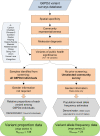Spatial distribution of G6PD deficiency variants across malaria-endemic regions
- PMID: 24228846
- PMCID: PMC3835423
- DOI: 10.1186/1475-2875-12-418
Spatial distribution of G6PD deficiency variants across malaria-endemic regions
Abstract
Background: Primaquine is essential for malaria control and elimination since it is the only available drug preventing multiple clinical attacks by relapses of Plasmodium vivax. It is also the only therapy against the sexual stages of Plasmodium falciparum infectious to mosquitoes, and is thus useful in preventing malaria transmission. However, the difficulties of diagnosing glucose-6-phosphate dehydrogenase deficiency (G6PDd) greatly hinder primaquine's widespread use, as this common genetic disorder makes patients susceptible to potentially severe and fatal primaquine-induced haemolysis. The risk of such an outcome varies widely among G6PD gene variants.
Methods: A literature review was conducted to identify surveys of G6PD variant frequencies among representative population groups. Informative surveys were assembled into two map series: (1) those showing the relative proportions of the different variants among G6PDd individuals; and (2) those showing allele frequencies of G6PD variants based on population surveys without prior G6PDd screening.
Results: Variants showed conspicuous geographic patterns. A limited repertoire of variants was tested for across sub-Saharan Africa, which nevertheless indicated low genetic heterogeneity predominated by the G6PD A(-202A) mutation, though other mutations were common in western Africa. The severe G6PD Mediterranean variant was widespread across western Asia. Further east, a sharp shift in variants was identified, with high variant heterogeneity in the populations of China and the Asia-Pacific where no single variant dominated.
Conclusions: G6PD variants exhibited distinctive region-specific distributions with important primaquine policy implications. Relative homogeneity in the Americas, Africa, and western Asia contrasted sharply with the heterogeneity of variants in China, Southeast Asia and Oceania. These findings will inform rational risk assessments for primaquine in developing public health strategies for malaria control and elimination, and support the future development of regionally targeted policies. The major knowledge gaps highlighted here strongly advocate for further investigation of G6PD variant diversity and their primaquine-sensitivity phenotypes.
Figures








References
-
- Carson PE, Flanagan CL, Ickes CE, Alving AS. Enzymatic deficiency in primaquine-sensitive erythrocytes. Science. 1956;124:484–485. - PubMed
-
- Howes RE, Piel FB, Patil AP, Nyangiri OA, Gething PW, Hogg MM, Battle KE, Padilla CD, Baird JK, Hay SI. G6PD deficiency prevalence and estimates of affected populations in malaria endemic countries: a geostatistical model-based map. PLoS Med. 2012;9:e1001339. doi: 10.1371/journal.pmed.1001339. - DOI - PMC - PubMed
Publication types
MeSH terms
Substances
Grants and funding
LinkOut - more resources
Full Text Sources
Other Literature Sources
Medical
Miscellaneous

